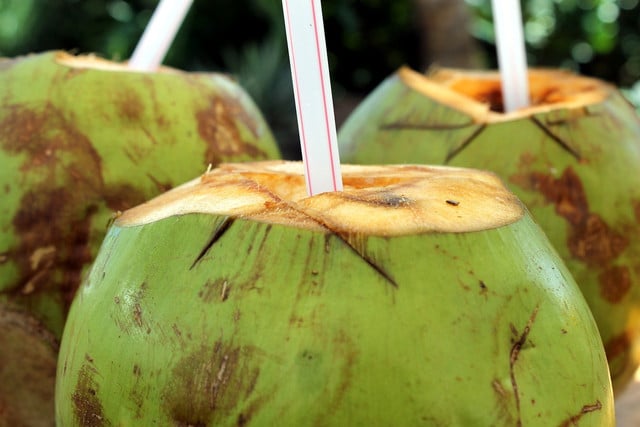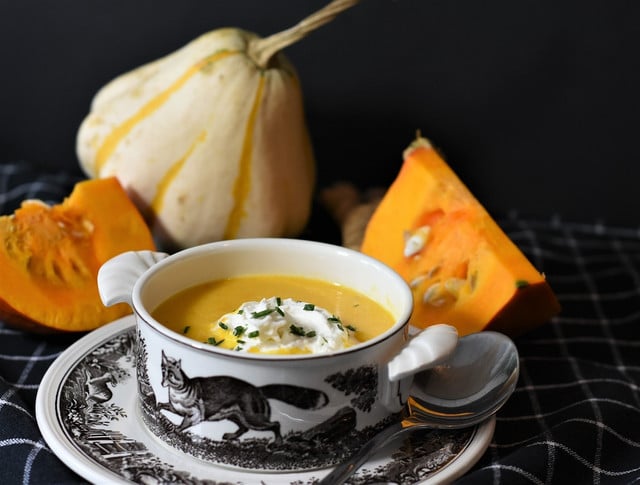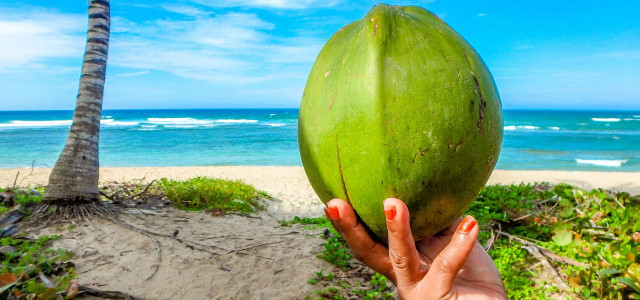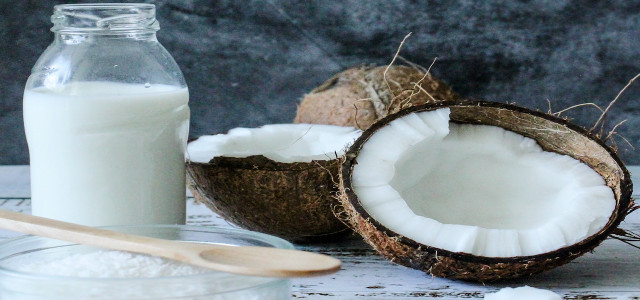Coconut water vs. coconut milk: two very different beverages from the humble coconut tree. Here is where they come from and if they’re sustainable.
You’ve probably come across coconut milk in recipes or restaurants. The thick, creamy liquid is a popular ingredient in Asian dishes like curries and soups. Coconut water, meanwhile, is a clear sweet liquid that tends to be used in cool drinks. So other than the obvious dissimilarities, what are the biggest differences between coconut water vs. coconut milk?
Coconut water comes directly from the coconut of the coconut palm tree. It is fat-free and can be drunk straight from the source. Conversely, coconut milk needs to be processed to transform into the form used for cooking.
We’ll discuss what you should know about how coconut water and coconut milk are produced and give you some ideas for using them. Let’s go.
Where Does Coconut Water Come From?

Coconuts grow on coconut palm trees in hot climates like Southeast Asia, Florida and Hawaii. Contrary to their name, they’re actually a fruit (drupes, botanically speaking), not a nut.
Immature coconuts are green on the outside. If harvested while green, they contain sweet coconut water. However, if left on the palm tree to mature until brown, that coconut water gets absorbed by coconut meat within the fruit or seed.
Coconut water is clear and fat-free, though it contains some calories and carbohydrates. It has a sweet taste and is less creamy than coconut milk. You can drink it directly from a fresh green coconut, and it is often served like this in restaurants in Southeast Asia — with the top cut off and a straw. It is also processed and sold in cartons in stores. Coconut water is pasteurized to remove any bacteria and prolong its shelf life. Check out these eight benefits of drinking coconut water.
How is Coconut Milk made?



Coconut milk comes from the meat of mature coconuts, shredded and soaked in hot water. During this process, coconut cream is removed from the surface of the water before the leftover liquid is strained. Coconut milk is vegan, a little fatty and bright white.
Coconut milk is used in cooking many curries and soups, as well as in desserts like puddings and in smoothies. It’s easy to find coconut milk in the grocery store; however, try making coconut milk at home for a rewarding activity that saves on excess packaging and shipping, which is greatly detrimental to the environment.
Coconut Milk vs. Coconut Water: Is Coconut Farming Sustainable?



Coconut farming is generally a moderately sustainable practice. No pesticides or herbicides are needed, there is little impact on water and air quality, and coconut trees don’t consume much water. That said, coconut farms are often planted after native forests are cleared, creating monocultures that reduce biodiversity and diminish soil quality.
Harvesting methods must be considered when discussing the sustainability of coconut farming. Coconuts are usually harvested by hand, which can be dangerous for workers exposed to the sun for long hours. Furthermore, coconut farm laborers often receive unfair wages — and there have been allegations of child labor in the industry. Sometimes, monkeys are even used for collecting the fruit, as they can work faster than humans and don’t require payment. This raises questions about the ethics of coconut farming.
Finally, as mentioned before, coconut trees grow in hot climates. The top-three global exporters are the Philippines, Indonesia and India. So, to get to the US, coconuts and related products must travel a long way — their carbon footprint is high. Coconut milk and coconut water also come packaged in containers that can be difficult to recycle, making both products less environmentally friendly.
One solution to these environmental and sustainability concerns is to consume fairtrade coconut products, ensuring workers are paid fairly and limiting ecological exploitation. Consuming coconut products only occasionally will also reduce your carbon footprint.
Delicious Recipes



Coconut milk has grown increasingly popular among those looking for the best plant-based milk. Check out these extra recipe ideas and tips for enjoying coconut milk and coconut water.
- 4 Delicious Coconut Milk Desserts. Yes, you can make desserts using coconut milk, including puddings, rice pudding and pancakes.
- Ube Jam. A sweet, creamy spread made from purple ube — delicious on a slice of toast.
- Carrot pasta. This easy sweet and creamy pasta dish is both healthy and satisfying.
- Easy and Delicious Vegan Truffles. These indulgent chocolate treats are easy to make at home using coconut milk.
- Pumpkin recipes. Have you ever tried coconut milk and pumpkin together? It’s a match made in culinary heaven.
- Electrolyte drinks. These two recipes use coconut water to give you a boost of hydration.
Read more:
- The 7 Best Yogurt Alternatives: Natural & Delicious
- Coconut Milk vs. Coconut Cream: What’s the Difference Anyway?
- Coconut Milk vs. Almond Milk: Which is Better for You and the Planet?
Do you like this post?







